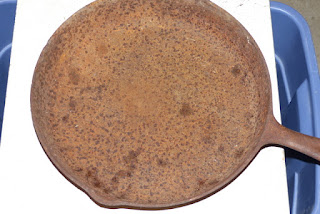This cast iron skillet spent many years outdoors and in the weather. It was rusty, rusty, rusty with surface pitting. However, it was not warped, cracked or damaged in any other way. I thought I'd see if there was any chance to restore it to usability.
 |
| Bottom side is very rusty but in good shape otherwise. No pitting. |
|
 |
| The rust in extensive inside the pan; deep and pitted. |
 |
Electrolysis is going to be my method in attempting to bring this skillet back to life.
So I start by suspending the skillet using copper wire and attached to metal object. I had a builders square handy so used it to hang the skillet. |
 |
| Next fill with water to cover skillet completely. Two metal rods in the water on each sides but not touching the skillet are the anodes in the circuit. The skillet is the cathode. Hard to see here but the skillet is hooked up to the negative lead and the rods to the positive lead of my battery charger. |
 |
| An electrolyte is needed. This super washing soda is sodium carbonate (not baking soda which is sodium bicarbonate.) 1 tablespoon per gallon of water. |
 |
| Battery charger which has manual settings. Used the highest setting (12v 6amp). Trickle chargers won't work I understand. |
 |
| About 20 hours after plugging the charger in it is obvious something is working. The water is beautifully rusty. |
|
 |
| After taking the skillet out of the solution and cleaning it up there is certainly drastic improvement. |
 |
| Then I took an SOS pad to it along with some hot water and scrubbed really well. |
 |
| Last step. Seasoned with light coat of oil and put it in the oven. Did this 3 times and pan looks terrific. Still has the pitting so I'll work on that next. |
 |
| Best of all, with the rust removed from the pan I can finally tell what I've got. The solid heat ring and numbering style on the bottom indicate a Birmingham Stove and Range skillet made sometime in the early 1960's. I haven't used it yet but will do so very soon. |











1 comment:
How fun!! Nice work.
Post a Comment